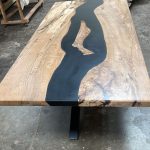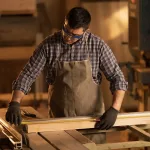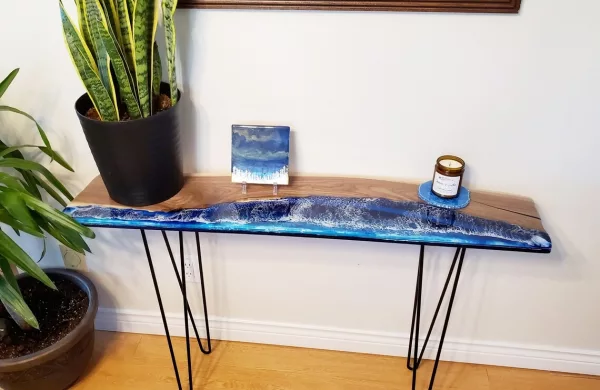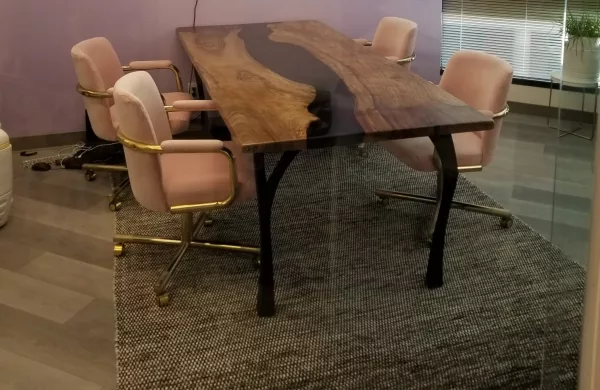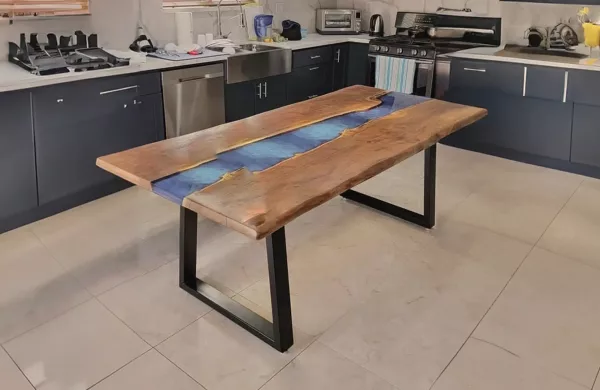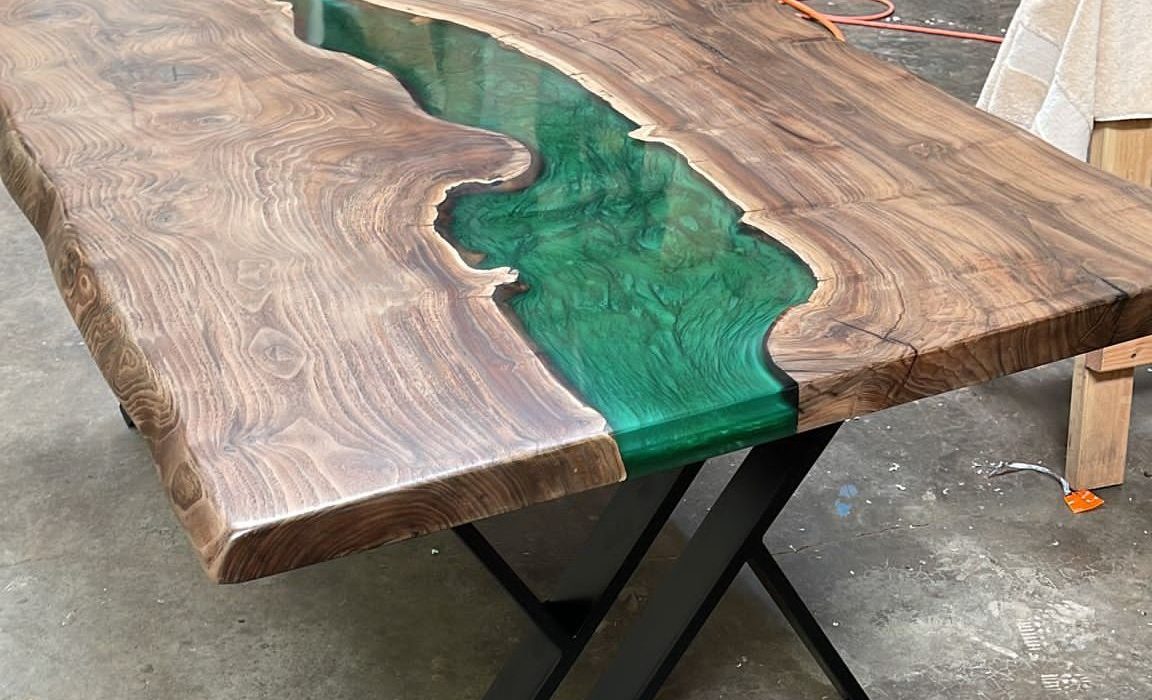
Epoxy table coating is more than just a protective layer – it’s a transformative art that adds depth, vibrancy, and durability to your creations. Whether you’re a seasoned craftsman or a newcomer to the world of epoxy resin, understanding the intricacies of epoxy table coating can elevate your projects to new levels of excellence. In this comprehensive guide, we’ll delve into the essential aspects of epoxy table coating, demystifying the terminology and techniques to help you achieve flawless results.
Mastering the Coating Terminology
Before we embark on our epoxy journey, let’s decode the terminology surrounding epoxy table coating. There are three primary types of epoxy coatings, each serving a distinct purpose:
- Epoxy Seal Coats: Picture them as the architects of a solid relationship between epoxy and the substrate. By penetrating the material’s tiny voids, the seal coat effectively seals the surface, minimizing the formation of air bubbles during the curing process. This meticulous sealing not only prevents unsightly bubbles but also enhances the overall durability of the final product. In essence, epoxy seal coats are the silent guardians ensuring a seamless and immaculate surface.
- Epoxy Flood Coats: Imagine a stage where aesthetics and resilience harmonize in perfect unison. Epoxy flood coats, with their enchanting self-leveling properties, grace your creation with a smooth, mirror-like finish. These coats are akin to a protective armor that not only enhances the allure of your project but also safeguards it against the rigors of daily use. Perfectly suited for high-traffic areas, epoxy flood coats shine as the final brushstroke, encapsulating your vision with elegance and endurance.
- Deep Pour Epoxy Coats: Deep pour epoxy coats are your gateway to crafting awe-inspiring river tables and intricate designs that transcend the ordinary. Uniquely formulated for applications demanding substantial depth, these coats exhibit a lower viscosity that thwarts the entrapment of air bubbles. They’re the artisans behind captivating projects that encapsulate the beauty of flowing rivers and intricate patterns. However, bear in mind that while these coats unleash creativity, they may not possess the same durability as other epoxy types.
Unveiling the Epoxy Coating Process
Now that we’ve introduced the coating types let’s dive into the step-by-step process to achieve impeccable epoxy-coated surfaces.
- Epoxy Seal Coats: Enhancing Bond and Durability: When working with porous substrates such as wood, applying an epoxy seal coat is crucial. This preliminary layer ensures optimal adhesion and minimizes air bubble formation. By brushing a thin layer of epoxy onto the surface, you force air out of pores, leaving behind a clean, fortified bond. For highly porous surfaces or embedded objects, two seal coats might be necessary.
- Epoxy Flood Coats: The Final Touch of Brilliance: Epoxy flood coats are the epitome of elegance and functionality. With self-leveling properties, these coats provide a sleek, mirror-like finish. Mixing epoxy according to instructions, you pour it directly onto the surface and distribute it evenly. The epoxy will naturally level out, creating a captivating 1/8-inch layer that protects and enhances your project. While one coat is usually sufficient, a second coat can be applied to achieve a thicker finish.
- Deep Pour Epoxy Coats: Bringing Creativity to Life: For projects demanding depth and dimension, deep pour epoxy coats are a game-changer. Utilizing specialized deep-pour epoxy, you can create breathtaking river tables and intricate castings. Due to its lower viscosity, deep-pour epoxy can be poured in thick layers without trapping air bubbles.
Achieving Excellence: Tips and Tricks
To ensure your epoxy coating endeavors yield remarkable results, consider these tips:
- Quality Resin for Exceptional Results: For flawless results, choosing a high-quality epoxy resin is essential. Choose a resin that complies with industry requirements because inferior options can reduce the projects’ long-term durability and aesthetic attractiveness. By using high-quality resin, you can be sure that your designs will endure while retaining their beauty.
- Mixing for Perfection: The art of epoxy coating demands thorough mixing. Blend the epoxy components completely as directed, making sure there are no streaks or unmixed areas. Consistency in mixing guarantees a uniform finish that enhances the beauty of your projects. By adhering to the recommended mixing process, you’re laying the foundation for a flawless result that showcases your craftsmanship.
- Bubble-Free Beauty: Air bubbles can mar the elegance of your epoxy-coated surfaces. To eliminate these unwanted blemishes, employ a foam brush to guide the resin into crevices and indentations. This process not only ensures proper coverage but also minimizes the likelihood of trapped air bubbles. For surface bubbles, a gentle sweep of an artist’s torch aids in dispersing them, leaving behind a smooth, captivating finish that captures the essence of your artistry.
- Perfect Timing for Seamless Integration: The art of epoxy coating embraces the significance of timing. When applying seal coats and flood coats, adhere diligently to the provided instructions. Following the recommended timelines ensures proper bonding and seamless integration between coats. This strategic approach guarantees that each layer melds harmoniously with the previous one, resulting in a unified masterpiece that exudes sophistication.
- Safety First: Epoxy work demands a cautious approach. Prioritize safety by donning protective gear such as gloves and eyewear. These simple precautions shield you from potential hazards, enabling you to focus on the creative process with confidence. By practicing caution, you’re not only safeguarding yourself but also ensuring that your artistic endeavors are carried out in a secure and controlled environment.
Elevating Craftsmanship with Epoxy Coating
Epoxy table coating is an art form that merges aesthetics with functionality. By mastering the nuances of seal coats, flood coats, and deep pour coats, you can transform ordinary surfaces into extraordinary works of art. Embrace the process, experiment with creativity, and adhere to best practices to achieve stunning results that endure the test of time. With epoxy coating, you’re not just protecting surfaces – you’re crafting a legacy of beauty and durability that captivates the eye and enriches the experience.





